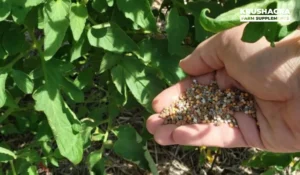Have you ever spotted white chalky patches or uneven spread of yellowish coating on leaves?
If yes, then you have come across the foliar diseases that the crops suffer from due to fungal infection, and expands more in presence of supportive weather conditions that can accelerate the contamination. It ruins the overall health of the plant as well as its aesthetic to a large extent. For farmers who are into large-scale agriculture and home gardeners who produce their foods, understanding the signs of such infections is of utmost importance. It is a valuable skill to understand the signals of damage at the first glance. This blog will guide you about such infections, how to understand the warnings and stop them from spreading further.
Powdery mildew and Downy mildew are two common types of fungal diseases that can stunt plant growth. Even when they produce fuzzy growth on leaves, both infections have different symptoms, different host plants, and grow in distinct climate conditions, and the pathogens that cause them are very distinct. Considering their characteristics, these mildews can be prevented well with help of appropriate treatment.
What is the difference between powdery and downy mildew?
Powdery mildew can be identified as white, talcum-powder-like patches that are largely seen on the upper as well as the bottom side of leaves, stems, buds, flowers, and fruits. These pinhead-sized spots are primarily white and then gradually transform to yellowish-brown and black.
It is caused by fungi like Erysiphe Cichoracearum and Sphaerotheca fuliginea which can get triggered in the presence of high humidity. It does not necessarily require wetness to disseminate. They can grow in moderate temperatures of 68 to 86°F and relative humidity of 95%, which indicates that it gets more severe in dry and warm climates. If there is a lack of proper distancing between crops or it is too crowded, the area is damp and has poor air circulation, it enhances the growth of powdery mildew.
It can affect a wide variety of crops like cereals, grasses, vegetables, ornamentals, weeds, shrubs, fruit trees, and forest trees. It is most commonly visible on susceptible plants like grapes, sunflowers, tomatoes, potatoes, roses, lettuce, melons, wheat, etc. Mostly the young and succulent plants are more susceptible. This fungus produces spores only on living plants and survives from one season to the next as vegetative strands called cleistothecia, on the bark of branches and stems.
The leaves become distorted and wilted and it also restricts the intake of water and nutrients in plants. They become weaker, progress slowly, and lead to less blossoming.
Downy mildew happens due to pathogens like Phylum Oomycota which spreads during humid and cold climatic conditions. It spreads more during rain, dew, and fog, unlike powdery mildew. This infection appears in the form of purplish-red, to dark-brown irregular spots on leaves. It usually occurs in young plant parts but other parts are also affected. These spores can be observed downside of leaf lesions. Brown and black splotches of tissue appear on the upper sides whereas the leaves curl, defoliating readily, and seedlings are stunted.
It infects ornamental plants/ garden plants and cucurbits like cucumbers, squash, pumpkin, melons, and gourds. Greenhouse crops like Pansy, sunflower, salvia and basil are capable of hosting this infection too. This fungus survives in plant debris as resting spores over unfavorable periods or on infected plants.
Prevention tips for powdery mildew
First and foremost, while monitoring the crops, when you notice the symptoms of powdery mildew, ensure to remove a few infected leaves as it will curb the further spreading of the disease. Do not compost any damaged foliage as the spores can spread and persist in the composted material. Disinfect pruners and all tools after use on infected plants.
Secondly, you should opt for resistant varieties that are less prone to get attacked by such infections. It’s an organic way of controlling crop damage and reducing or almost avoiding the use of pesticides.
Do the regular cutting of susceptible plants to allow enough air circulation within the crop. This is also ensured by maintaining proper distance between two plants as it helps in reducing the relative humidity as well. Plant them in a space that gathers sufficient sunlight.
The organic way of disinfecting the plant is to make homemade solutions that can be applied to affected plants. Curative fungicides like Baking soda solution, Potassium bicarbonate, milk, and neem oil are some examples that can cure the disease if implemented well. Spraying this evenly on the afflicted areas. Application of these solutions on regular basis for 3-4 weeks would be enough to gauge the result. In the case of chemicals, you should opt for sulfur-containing fungicides for both the prevention and treatment of existing infections.
Krushagra’s biopesticides, like Tricofit – Ⅰ and Tricofit- Ⅱ, will protect the plants from the attack of soil-borne pathogens that also cause root, collar, stem rots, wilts, damping offs, leaf blights spots, and Nematode. Tricofit – Ⅰ (Trichoderma viride) is recommended for all agriculture, horticulture, greenhouse, and forest crops/ plants. Whereas Tricofit- Ⅱ (Trichoderma harzianum ) can be used for agriculture, horticulture, forestry, medicinal and aromatic plants, avenue plantations plus floriculture crops/plants as well.
Prevention tips for downy mildew
Much like powdery mildew, you should use resistant cultivator plants to avert downy mildew too. Remove the infected part immediately when you come across the first signs itself, keep it in a carry bag, and then dump it in the dustbin. Avoiding composting it in the soil as most home compost piles are not hot enough to kill the downy mildew pathogen.
Similar to powdery mildew, you should ensure the right amount of space between the plants to allow adequate air circulation. Do not water the plants from the top. Overhead irrigation wets the leaves and If you must water from the top, water in the early morning hours, before 10:00 a.m. so the leaves will dry before nightfall.
The best way to water plants is by using drip irrigation. The water comes out at the emitters at ground level and sinks right to the roots. It is affordable as well. In both powdery and downy mildew, you should perform root maintenance by ensuring appropriate fertilization, watering, and aeration as insisted.
When using any fungicide, you should spray until the entire leaf is wet on top and the underside of the leaf. Spores exist on both surfaces. Copper fungicides are often used to control downy mildew. Although, it is only a conditionally approved fungicide. Care must be used in cucurbit crops because copper makes them photosensitive. Copper levels can build up in the soil and kill earthworms and other beneficial organisms. In that case, using bio fungicides is beneficial as it maintains soil fertility and does not restrict crop yield.
Krushagra Pseudofit is highly effective in cases of downy as well as powdery mildew. It protects the roots of plant species against parasitic fungi and It induces systemic resistance in the host plant, so it can better resist attack by a true pathogen.






